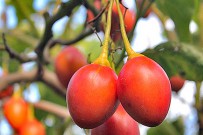-

-
We are specialists for your holidays in La Palma. With personalized assistance on-site.
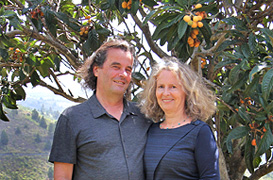
Ulrich & Evelyn Roth -
Our service numbers
Write e-mail+34 822 68 00 89
+49 7442 819 85 90
We're available from Monday to Friday from 10:00 a.m. to 6:00 p.m., and Saturdays from 10:00 a.m. to 1:00 p.m.
-
Accommodations
- with pool 90
- on the seaside 42
- with internet 204
-
Northwest >>
130
- Aguatavar 7
- Arecida 6
- El Castillo 1
- Garafía 4
- Las Tricias 7
- Puntagorda 42
- Tijarafe 22
- Tijarafe Costa 6
- Tijarafe El Jesús 12
- Tijarafe La Punta 21
- Tinizara 2
-
Aridane Valley >>
225
- Celta 7
- Charco Verde 3
- El Paso 23
- Hermosilla 1
- La Bombilla 2
- La Laguna 11
- Las Manchas 24
- Las Norias 11
- Los Llanos de Aridane 25
- Puerto de Naos 45
- San Nicolas 8
- Tacande 2
- Tajuya 9
- Tazacorte Costa 5
- Tazacorte Puerto 14
- Tazacorte Villa 23
- Todoque 12
-
South >>
31
- Fuencaliente 7
- Las Indias 4
- Lomo Oscuro 1
- Los Quemados 6
- Salemera 2
- Tigalate 2
- Villa de Mazo 9
- East >> 16
-
Northeast >>
5
- Barlovento 2
- Los Sauces 2
- Puntallana 1
Tamarillo or Tree Tomatoes
The 2 - 5 meter high tree-like Tamarillo Shrub originates from the South American Andes
„tamarillo“
Tree Tomato
Solanum betaceum, Cyphomandra betacea
Tree Tomatoes belong to the nightshade family but are no real tomatoes: The harshly-sweet fruits contain vitamins A, C, E, and different B-group vitamins as well as potassium, magnesium, calcium, iron and phosphor.
Propagation from Seeds that can also be grown from the Flower Tub
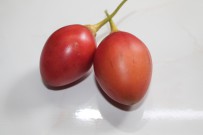 Because of its fruits, the shrub is cultivated in many countries worldwide and in a smaller scale also on the Canary Islands.
Because of its fruits, the shrub is cultivated in many countries worldwide and in a smaller scale also on the Canary Islands.
The name tree tomato can be misleading, as the only thing a tamarillo and a tomato have in common is that both belong to the nightshade family.

There are two scientific names: Solanum betaceum and Cyphomandra betacea.
„Tamarillo“, as it is called in Spanish, requires a clayey soil.

It also doesn't like sunny places and needs a place sheltered from the wind.
The crown of the evergreen shrub is umbrella-shaped. Its trunk and old shoots are brownish, younger shoots are green.
Leaves are elongated or heart-shaped with visible, light veins.
 Around May or June the light blossoms open.
Around May or June the light blossoms open.
They are tinged with rosé and hang down in small groups.
The egg-shaped fruits grow slowly and change colour from green to red.
By October/November Fruits are Ready for Harvesting
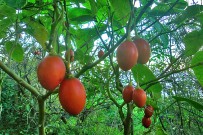 Like coloured Easter eggs they hang down from the tree on long stalks.
Like coloured Easter eggs they hang down from the tree on long stalks.
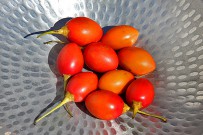
Tree tomatoes have a firm, leathery fruit skin and will yield to slightly finger press when ripened.
Cut in two halves like kiwis, the pulp of the fruit can be spooned out and enjoyed together with the small seeds.
In this way their flavour will be more intense. Tamarillos taste aromatic and harsh-sweet.

When fruits are peeled before they are eaten, the outer fruit flesh slightly reduces the sweetness.
Tree tomatoes contain vitamins A, C, E and different B-group vitamins as well as potassium, magnesium, calcium, iron and phosphor.
Peeled fruits can also be added to salads or cooked like tomatoes or used for making jam.
Photos: Ines Dietrich, Uka Rösch


